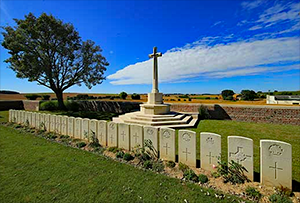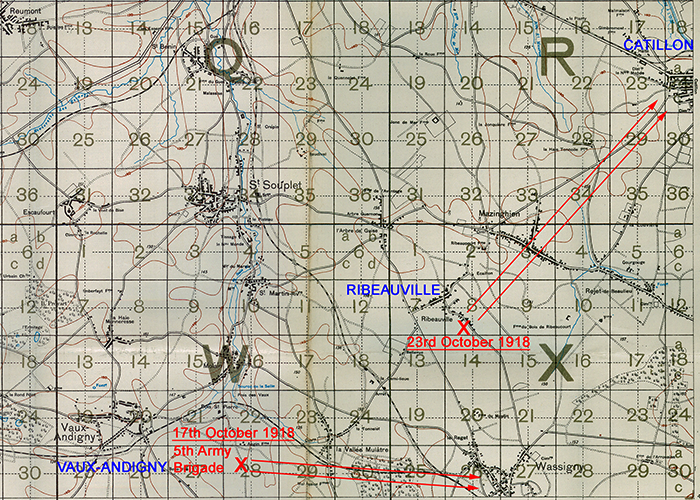First World War Project
Thomas James LAVENDER (of Luddenham)
bapt. 8th January 1899 Signaller, Service Number 181560 |

Born in Murston (No.7 Carter's Cottages), he was baptised in Luddenham, the only son of farm labourer Thomas James and Annie (née Stevens/Stephens) Lavender, of Luddenham, Faversham. In 1911, the parental home was at Four Oaks, Luddenham, near Faversham. In the 1939 records, his parents are both alive and living as pensioners in Luddenham but in Nash's Cottages.
While Thomas was born and raised in Luddenham, his extended family came almost entirely from Sussex. His father and his family from Burwash, although his mother came from Staplehurst in Kent. This was a family of agricultural workers.
| Faversham and North East Kent News of 7th December 1918 |
| SIGNALLER, T.J. LAVENDER, R.F.A. Mr and Mrs Thomas Lavender, of Luddenham, have also received news from the War Office of the death of their only son, Thomas James Lavender. He joined the army in January last [1917], at the age of eighteen, before which he was working for Mr Ashley Stevens, at Luddenham Court. He became a signaller in the Royal Field Artillery and was home on leave in August. He went to France at the end of September and met his death on October 23rd, when he was killed in action. |
Being part of an artillery team during WW1 was hazardous during trench warfare as each side tried to knock out the others' guns that protected the trenches and disrupted the opponents' artillery. In this scenario, the Signaller was placed in the particularly difficult position of maintaining communication back to their Battery. They did this from the Front trenches and forward posts - laying and repairing telephone wires, using morse signalling with lamps, or using flags and wooden signalling "shutters" to keep their Batteries accurate. All of which made them obvious targets for snipers, mortars, gas and high-explosive artillery. Signallers usually operated in pairs - if one was killed, there may be a chance the other would carry on. Without Signallers, the Battery could not fire its rounds as they could not be sure how accurate their firing was nor whether their own troops had moved forward.
When fighting became more mobile in the closing 100-days of the Allied attack, the Front Line was less stable so that maintaining continuous communication became much more risky. If laying telephone lines was not possible, then Signalling would have to be done more visibly - shutter systems, lights and flags. Perfect target practice for the opposition. Often, the signallers would have to work in pitch black to find and repair broken lines.
The War Gratuity paid at death was £8 - confirming the enlistment period. His personal effects of £3 15s. 9d were paid to his father in 1919. [See Appendix 2]
He was posthumously awarded the British War and Victory medals. [See Appendix 1]
Military Experience of Thomas James Lavender
Thomas enlisted at Canterbury, Kent, in January 1917. He was ultimately to join the 81st Battery of the 5th Brigade which had left India for France during 1916. Royal Field Artillery units were relatively mobile, underpinning front positions as needed.
The 5th Brigade (made up of 64th, 73rd and 81st Batteries) was a unit of Britain's pre-war regular army in India before it left for France. It fell successively under the command of the 3rd Canadian Division, and the 4th Canadian Division (September 1916). It became an Army Brigade in July 1917.
The 5th Army Brigade served with the Second Army in October 1917, the Third Army in December 1917, the First Army in February 1918, the Fifth Army in July 1918 and finally in the Fourth Army in October 1918 - the month that Thomas died.
Circumstances of the death of Thomas James Lavender
81st Battery was operating on the Aisne Front north-west of Saint Quentin at the time of Thomas's death. Based around Vaux-Andigny, firing in the direction of Catillon-sur-Sambre.
The 5th Army Brigade War Diary is fairly short on detail but does show how flexible the Batteries had to be as they fell under various Commands in support of local attacks by ground troops:-
1st October: BELLENGLISE (G.34.c.5.7, Sheet 62B): The 5th Army Brigade R.F.A. under IX Corps, attached to 46th D.A.
2nd October: Transferred to 32nd D.A.
3rd October: Brigade remained in observation.
4th October: ETRICOURT (H.19.a.8.7, Sheet 62B): 4.30 am: Brigade marched into action East of ST. QUENTIN CANAL. Batteries located at H.15.c. & d. Fired barrage to cover attack by Australians on MONTBREHAIN.
5th October: Brigade remained in positions of observation. Transferred to 46th D.A. Under Left Group.
6th October: ditto.
7th October: JONCOURT (H.15.c.8.5): 7 p.m.: Brigade moved forward into positions S.E. of JONCOURT.
8th October: 5.10 a.m.: Fired barrage in support of attack by 6th Division towards FRESNOY and MERICOURT. Cavalry followed up through BRANCOURT.
9th October: 5.20 a.m.: Brigade fired barrage to support attack on BOHAIN.
5 p.m.: Brigade pulled out of action and proceeded to Wagon Lines. Affiliated to 18th Infantry Brigade Group (under 6th Divisional Artillery).
10th October: BRANCOURT BOHAIN (D.15.b.): 10 a.m.: Brigade moved up to BRANCOURT.
11th October: Batteries in action in D.5.c. & d. N.E. of BOHAIN.
12th October: 5th Army Brigade became responsible for Group Artillery. D/5 Battery rejoined as 4 howitzer Battery.
13th to 15th October: Batteries in observation.
16th October: Brigade came under orders of O.C. Right Group 6th D.A. Moved forward to positions in V.30.a (Sheet 57B).
17th October: VAUX ANDIGNY: 5.20 a.m.: Batteries in W.28.a. Fired Barrage in support of attack on WASIGNY. H.Q. removed to VAUX ANDIGNY.
18th October: 11.30 a.m.: Fired barrage to cover attack on WASSIGNY.
19th October: Brigade moved forward to N.E. of WASSIGNY.
20th October: Attached tactically to 1st D.A. in Left Group, under command of C.R.A. 32nd Divisional Artillery.
21st October: RIBEAUVILLE (X.8.c.8.3., Sheet 57B): Brigade in observation
22nd October: ditto.
23rd October: 01.20 am: Barrage fired to cover attack towards CATILLON by 32nd Division.
24th to 27th October: Brigade ordered into Corps reserve.
With this sequence of events, it is plausible that Thomas died while directing the barrage fired towards CATILLON.


 World War 1 Pages
World War 1 Pages